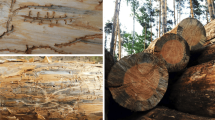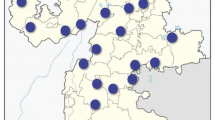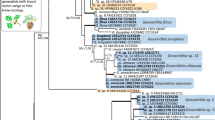Abstract
Nematode pathogens cause wilt diseases in conifers and deciduous trees. The longhorn beetles (Coleoptera: Cerambycidae) and bark beetles (Coleoptera: Curculionidae: Scolytinae) act as nematode vectors spreading the invasive juvenile stages during their maturation feeding or during oviposition on the plant hosts. There are numerous reviews of nematodes associated with bark beetles on conifers, while little attention has been paid to the nematodes of deciduous trees. The development of Dutch elm disease and ash dieback is mainly caused by fungal pathogens transmitted by bark beetles; the latter act as vectors of not only fungi but also nematodes enclosed in nematangia under their elytra, and also in the tracheae and Malpighian canals. Apart from phytopathogenic nematodes, bark beetles transmit mycophagous and bacterivorous nematodes and own parasites of bark beetles. The ecological groups of nematodes associated with Scolytinae are reviewed; the known records of associations of nematodes with bark beetles are listed for coniferous host plants of Russia and neighboring countries; the world-wide list of these associations for deciduous plant hosts is given.
Similar content being viewed by others
References
Balder, H., “Neuartiges Eichensterben in Berlin,” Allgemeine Forst-Zeitschrift 42, 684–685 (1987).
Balder, H., “Studies on a New Type of Dieback Symptoms on Oaks in the Berlin Forest,” Nachrichtenblatt des Deutschen Pflanzenschutzdienstes 41, 1–6 (1989).
Bedding, R., “Low Cost in Vitro Mass Production of Neoaplectana and Heterorhabditis Species (Nematoda) for Field Control of Insect Pests,” Nematologica 27(1), 109–114 (1981).
Bedding, R., “Large Scale Production, Storage and Transport of the Insect-Parasitic Nematodes Neoaplectana spp. and Heterorhabditis spp.,” Annals of Applied Biology 104, 117–120 (1984).
Bedding, R.A. and Iede, E.T., “Application of Beddingia siricidicola for Sirex Woodwasp Control,” in Nematodes as Biocontrol Agents, Ed. by Grewal, P.S., Ehlers, R.-U., and Shapiro-Ilan, D.I. (CAB International, Wallingford, 2005), pp. 385–399.
Braasch, H., Burgermeister, W., and Pastrik, K.H., “Differentiation of Three Bursaphelenchus Species by Means of RAPD-PCR,” Nachrichtenblatt des Deutschen Pflanzenschutzdienstes 47(12), 310–314 (1995).
Braasch, H., Tomiczek, Ch., Metge, K., Hoyer, U., Burgermeister, W., Wulfert, I., and Schoènfeld, U., “Records of Bursaphelenchus spp. (Nematoda, Parasitaphelenchidae) in Coniferous Timber Imported from the Asian Part of Russia,” Forest Pathology 31, 129–140 (2001).
Burjanadze, M., Lortkipanidze, M., Supatashvili, A., and Kajaia, G., “Nematodes Associated with Bark Beetle Ips typographus in Borjomi Gorge,” Zoology 9, 163–167 (2015).
Campião, K., Dantas, S., Tavares, H.D., Martins, J.K.V., and Oda, F.H., “Dwarf vs Giant: An Unexpected Interaction between a Small Treefrog and a Large Nematode,” Food Webs 16: e00102 (2018).
Carletti, B., Ambrogioni, L., Irdani, T., Brandstetter, M., Puleri, F., Surico, F., Pennacchio, F., and Roversi, P.F., “Morphometrics and Molecular Identification of Some Italian Populations of Bursaphelenchus eremus Rühm (Goodey) Associated with Quercus spp.,” Redia 90, 3–21 (2007).
Devdariani, Ts.G., “A New Nematode Species, Tylaphelenchus georginsis Devdariani nov. sp. (Nematoda: Aphelenchidae),” Soobshcheniya Akademii Nauk Gruzinskoi SSR 58(3), 717–720 (1970).
Ebsary, B.A., Catalog of the Order Tylenchida (Nematoda) (Research Branch Agriculture, Ottawa, 1991).
Fuchs, A.G., “Neue parasitische und halbparasitische Nematoden bei Borkenkäfern und einige andere Nematoden. I. Teil die Parasiten der Waldgartner Myelophilus piniperda L. und minor Hartig und die Genera Rhabditis Dujardin, 1845 und Aphelenchus Bastian, 1865,” Zoologische Jahrbücher, Abteilung für Systematik, Oekologie und Geographie der Tiere 70, 291–380 (1937).
Grucmanova, S. and Holusa, J., “Nematodes Associated with Bark Beetles, with Focus on the Genus Ips (Coleoptera: Scolytinae) in Central Europe,” Acta Zoologica Bulgarica 65(4), 547–556 (2013).
Gu, J., Tomalak, M., He, J., and Fang, Y., “Bursaphelenchus crenati Rühm, 1956 (Tylenchina: Aphelenchoididae), a Nematode Associated with the Greater Ash Bark Beetle, Hylesinus crenatus Fabricius, in Dying Ash, Fraxinus excelsior L., in Europe,” Nematology 19(4), 413–426 (2017).
Gu, J., Tomalak, M., Braasch, H., and Fang, Y., “Redescription of Bursaphelenchus eucarpus Rühm, 1956 (Nematoda: Aphelenchoididae) Associated with the Apple Bark Beetle, Scolytus mali Bechstein, and the Shothole Borer, S. rugulosus Müller,” Nematology 20(9), 889–903 (2018).
Hunt, D.J., Aphelenchida, Longidoridae and Trichodoridae: Their Systematics and Bionomics (CAB International, Wallingford etc., 1993).
Kakulia, G.A., “A New Nematode Genus, Devibursaphelenchus Kakulia gen. n. (Nematoda: Aphelenchoididae),” Soobshcheniya Akademii Nauk Gruzinskoi SSR 46(2), 439–443 (1967).
Kakulia, G.A. and Devdariani, Ts.G., “A New Nematode Species, Bursaphelenchus teratospicularis Kakulia et Devdariani, sp. nov. (Nematoda: Aphelenchoidea),” Soobshcheniya Akademii Nauk Gruzinskoi SSR 38, 187–191 (1965).
Kakulia, G.A. and Devdariani, Ts.G., “Nematofauna of the Larger European Elm Bark Beetle (Scolytus scolytus F.) in Eastern Georgia,” Soobshcheniya Akademii Nauk Gruzinskoi SSR 46(2), 469–474 (1967).
Kakulia, G.A. and Devdariani, Ts.G., “Comparative Analysis of the Nematofauna of Bark and Longhorn Beetles in Eastern Georgia,” in Materials on the Fauna of Georgia, Issue 5 (Metsniereba, Tbilisi, 1975), pp. 39–46 [in Russian].
Kakulia, G.A. and Maglakelidze, L.K., “Nematofauna of the Lesser Spruce Shoot Beetle (Hylurgops palliatus Gyll.) in Georgia,” Parazitologicheskii Sbornik 3, 78–79 (1973).
Kakulia, G.A., Devdariani, Ts.G., and Maglakelidze, L.K., “Nematofauna of Bark Beetles (Ipidae) and Longhorn Beetles (Cerambycidae) in the Environs of Zhinvali,” Parazitologicheskii Sbornik 4, 119–126 (1977).
Kakulia, G.A., Devdariani, Ts.G., and Maglakelidze, L.K., “Nematodes Associated with Longhorn Beetles (Cerambycidae) on the Woody Plants in Eastern Georgia,” in Abstracts of Papers of the 9th Conference of the Ukrainian Parasitological Society, Vol. 2 (1980), pp. 109–110.
Kalko, G.V., “Ophiostoma-Induced Wilting of Elms in St. Petersburg,” Zashchita i Karantin Rastenii 3, 48–49 (2009).
Kanzaki, N. and Futai, K., “Description of Bursaphelenchus parvispicularis n. sp. (Nematoda: Parasitaphelenchidae) Isolated from a Dead Oak Tree, Quercus mon-golica var. grosseserrata,” Nematology 7(5), 751–759 (2005).
Kanzaki, N., Maehara, N., and Masuya, H., “Bursaphelenchus clavicauda n. sp. (Nematoda: Parasitaphelenchidae) Isolated from Cryphalus sp. Emerged from a Dead Castanopsis cuspidata (Thunb.) Schottky var. sieboldii (Makino) Nakai in Ishigaki Island, Okinawa, Japan,” Nematology 9(6), 759–769 (2007).
Kanzaki, N., Maehara, N., Aikawa, T., Masuya, H., and Giblin-Davis, R., “Description of Bursaphelenchus kiyoharai n. sp. (Tylenchina: Aphelenchoididae) with Remarks on the Taxonomic Framework of the Parasitaphelenchinae Rühm, 1956 and Aphelenchoidinae Fuchs, 1937,” Nematology 13(7), 787–804 (2011).
Kanzaki, N., Giblin-Davis, R., Gonzalez, R., Duncan, R., and Carrillo, D., “Description of Ruehmaphelenchus juliae n. sp. (Tylenchina: Aphelenchoididae) Isolated from an Ambrosia Beetle, Xylosandrus crassiusculus (Motschulsky), from South Florida,” Nematology 17(6), 639–653 (2015).
Kanzaki, N., Ekino, T., Ide, T., Masuya, H., and Degawa, Y., “Three New Species of Parasitaphelenchids, Parasitaphelenchus frontalis n. sp., P. costati n. sp. and Bursaphelenchus hirsutae n. sp. (Nematoda: Aphelenchoididae), Isolated from Bark Beetles from Japan,” Nematology 20(10), 957–1005 (2018). DOI: https://doi.org/10.1163/15685411-00003189.
Kim, D.G. and Robbins, R.T., “A New Nematode Species (Aphelenchida: Aphelenchoididae) Associated with the Bark Beetle, Scolytus seulensis, in Korea,” Journal of Asia-Pacific Entomology 11(1), 31–35 (2008).
Korenchenko, E.A., “New Nematode Species of the Family Aphelenchoididae, Parasites of Trunk Pests of the Dahurian Larch,” Zoologicheskii Zhurnal 59(12), 1768–1780 (1980).
Kubátová, A., Novotný, D., Práil, K., and Mrácek, Z., “The Nematophagous Hyphomycete Esteya vermicola Found in the Czech Republic,” Czech Mycology 52(3), 227–235 (2000).
Kulinich, O.A. and Ryss, A.Yu., “Wood Nematodes of the Genus Bursaphelenchus in the Territory of Russia,” in Applied Nematology, Ed. by Zinovieva, S.V. and Chizhov, V.N. (Nauka, Moscow, 2006), pp. 162–185 [in Russian].
Kurashvili, B.E., Kakulia, G.A., and Devdariani, Ts.G., Parasitic Nematodes of the Bark Beetles in Georgia (Metsniereba, Tbilisi, 1980) [in Russian].
Marianelli, L., Marziali, L., Carletti, B., Pennacchio, F., Cotroneo, A., and Roversi, P., “Associação Scolytus intricatus - Bursaplelenchus eremus em Carvalhos em Itália,” Silva Lusitana 19, 101–104 (2010).
Massey, C.L., “Omemeea maxbassiensis n. gen., n. sp. (Nematoda: Aphelenchoididae) from Galleries of the Bark Beetle Lepersinus californicus Sw. (Coleoptera: Scolytidae) in North Dakota,” Journal of Nematology 3(3), 289–291 (1971).
Massey, C.L., Biology and Taxonomy of Nematode Parasites and Associates of Bark Beetles in the United States (Agricultural Handbook 446) (United States Department of Agriculture, Washington, 1974).
Mikaia, N., Devdariani, T., and Gninenko, Y., “Representatives of Nematodes of the Genus Bursaphelenchus (Aphelenchida, Parasitophelenchidae) in Georgia,” Bulletin of the Georgian National Academy of Sciences 4(1), 146–151 (2010).
Musolin, D.L., Selikhovkin, A.V., Shabunin, D.A., Zviagintsev, V.B., and Baranchikov, Y.N., “Between Ash Dieback and Emerald Ash Borer: Two Asian Invaders in Russia and the Future of Ash in Europe,” Baltic Forestry 23(1), 316–333 (2017).
Polyanina, K.S., Subbotin, S.A., Sazonov, A.A., Zvyagintsev, V.B., Petrov, A.V., Mandelshtam, M.Yu., and Ryss, A.Yu., “Nematofauna Associated with Wilt of the European Ash Fraxinus excelsior L. and the Finding of Bursaphelenchus crenati Rühm (Nematoda: Aphelenchoididae) in Russia and Belarus,” in The Kataev Memorial Readings - X. Dendrobiont Invertebrates and Fungi and Their Role in Forest Ecosystems, Vol. 1: Insects and Other Invertebrates, Ed. by Musolin, D.L. and Selikhovkin, A.V. (St. Petersburg State Forest Technical University, St. Petersburg, 2018), p. 84.
Rühm, W., “Die Nematoden der Ipiden,” Parasitologische Schriftenreihe 6, 1–437 (1956).
Ryss, A.Yu., “Ways of the Parasitism Origin in the Phytonematode Orders Tylenchida and Aphelenchida,” Trudy Zoologicheskogo Instituta Rossiiskoi Akademii Nauk 313(3), 257–272 (2009).
Ryss, A.Yu., “The Origin of Phytoparasitism in Nematodes and Their Coevolution with Hosts and Vectors, by the Example of Aphelenchoidea. Chapter III,” in Coevolution of Parasites and Hosts: a Multi-Author Monograph, Ed. by Galaktionov, K.V. (Zoological Institute, St. Petersburg, 2016), pp. 127–159 [in Russian].
Ryss, A. and Polyanina, K., “Xylobiont Nematodes Parasitizing Elm Ulmus glabra in Parks of St. Petersburg, Russia,” Russian Journal of Nematology 23(2), 168 (2015a).
Ryss, A. and Polyanina, K., “Diagnostics of the Stages of Post-Embryonic Development in Bursaphelenchus ulmophilus (Nematoda: Aphelenchoididae),” Parazitologiya 51(6), 466–480 (2017).
Ryss, A. and Polyanina, K., “Characterization of Juvenile Stages of Bursaphelenchus crenati Rühm, 1956 (Nematoda: Aphelenchoidoidea),” Journal of Nematology 50, 459–472 (2018).
Ryss, A.Yu. and Mokrousov, M.V., “Analysis of Climatic and Biological Parameters for the Spread Risk Modeling of the Wood Nematodes Bursaphelenchus spp. and Devibursaphelenchus teratospicularis (Rhabditida: Aphelenchoidea),” Parazitologiya 48(6), 454–460 (2014).
Ryss, A.Y. and Mokrousov, M.V., “The Analysis of Climatic and Biological Parameters for the Pest Spread Risk Modeling of the Wood Nematode Species Bursaphelenchus spp. and Devibursaphelenchus teratospicularis (Rhabditida: Aphelenchoidea),” Russian Journal of Nematology 23, 167 (2015a).
Ryss, A.Y. and Mokrousov, M.V., “The Analysis of Climatic and Biological Parameters for the Pest Spread Risk Modeling of the Wood Nematode Species Bursaphelenchus spp. and Devibursaphelenchus teratospicularis (Rhabditida: Aphelenchoidea),” in International Nematological Symposium. Nematoda and Ecdysozoa. July 05–11. Cheboksary, Russia, Vol. 1 (2015b), p. 47.
Ryss, A.Y. and Mokrousov, M.V., “Saproxylic Nematodes of the Nizhny Novgorod Region of Russia and Parameters for Risk Modeling of Forest Wilt in Conditions of the Anthropogenic Stress,” in Abstracts of the 12th International Symposium of the Russian Society of Nematologists “Nematodes and Other Ecdysozoa under the Growing Ecological Footprint on Ecosystems,” Nizhny Novgorod, Russia, July 31–August 6, 2017, Ed. by Zryanin, V.A. and Ryss, A.Y. (Lobachevsky State University of Nizhny Novgorod, 2017), p. 88.
Ryss, A., Vieira, P., Mota, M., and Kulinich, O., “A Synopsis of the Genus Bursaphelenchus Fuchs, 1937 (Aphelenchida: Parasitaphelenchidae) with Key to Species,” Nematology 7(3), 393–458 (2005).
Ryss, A., Polyanina, K., Popovichev, B., and Subbotin, S., “Description of Bursaphelenchus ulmophilus sp. n. (Nematoda: Parasitaphelenchinae) Associated with Dutch Elm Disease of Ulmus glabra Huds. in the Russian North-West,” Nematology 6(17), 685–703 (2015b).
Ryss, A.Yu., Polyanina, K.S., and Skryabina, M.D., “Wood-inhabiting Nematodes of Deciduous Trees: Life Cycle and Plant Host Specificity,” Trudy Tsentra Parazitologii 50, 216 (2018).
Sauvard, D., Branco, M., Lakatos, F., Faccoli, M., and Kirkendall, L., “Chapter 8.2. Weevils and Bark Beetles (Coleoptera, Curculionoidea),” in Alien Terrestrial Arthropods of Europe, Ed. by Roques, A., Kenis, M., Lees, D., Lopez-Vaamonde, C., Rabitsch, W., Rasplus, J.-Y., and Roy, D.B. (Pensoft, Sofia-Moscow, 2010), pp. 219–266.
Schauer-Blume, M., “Bursaphelenchus ‘mucronatus’ (Nematoda, Aphelenchoididae) an Laubbäumen in Deutschland,” Nachrichtenblatt des Deutschen Pflanzenschutzdienstes 39(10), 152–154 (1987).
Schauer-Blume, M. and Sturhan, D., “Vorkommen von Kiefernematoden (Bursaphelenchus spp.) in der Bundesrepublik Deutschland?” Nachrichtenblatt des Deutschen Pflanzenschutzdienstes 41(8/9), 133–136 (1989).
Shcherbakova, L.N. and Mandelshtam, M.Yu., “Elms of St. Petersburg: the Final Warning,” in The Kataev Memorial Readings - VIII. Pests and Diseases of Trees in Russia. Proceedings of the International Conference, St. Petersburg, 18–20 November 2014 (St. Petersburg State Forest Technical University, St. Petersburg, 2014), pp. 97–98.
Tomalak, M. and Filipiak, A., “Bursaphelenchus trypophloei sp. n. (Nematoda: Parasitaphelenchinae) - An Associate of the Bark Beetle, Trypophloeus asperatus (Gyll.) (Coleoptera: Curculionidae, Scolytinae), in Aspen, Populus tremula L.,” Nematology 13(5), 619–636 (2011).
Tomalak, M. and Filipiak, A., “Bursaphelenchus fagi sp. n. (Nematoda: Parasitaphelenchidae), an Insect Pathogenic Nematode in Malpighian Tubules of the Bark Beetle, Taphronychus bicolor Herbst. (Coleoptera: Curculionidae, Scolytinae) in European Beech, Fagus silvatica,” Nematology 16, 591–606 (2014).
Tomalak, M. and Malewski, T., “Bursaphelenchus tiliae sp. n. (Nematoda: Parasitaphelenchidae), a Nematode Associate of the Bark Beetle Ernoporus tiliae (Panz.) (Coleoptera: Curculionidae, Scolytinae), in Small-Leaved Lime, Tilia cordata Mill.,” Nematology 16(10), 1181–1196 (2014).
Tomalak, M., Malewski, T., Gu, J., and Fa-Qiang, Z., “Description of Bursaphelenchus taphrorychi sp. n. (Nematoda: Parasitaphelenchidae), the Second Bursaphelenchus Species from Larval Galleries of the Beech Bark Beetle, Taphrorychus bicolor (Herbst) (Coleoptera: Curculionidae: Scolytinae), in European Beech, Fagus sylvatica L.,” Nematology 19(10), 1217–1235 (2017).
Wood, S.L. and Bright, D.E., “A Catalog of Scolytidae and Platypodidae (Coleoptera), Part 2, Taxonomic Index,” Great Basin Naturalist Memoirs 13(A), 1–833 (1992a).
Wood, S.L. and Bright, D.E., “A Catalog of Scolytidae and Platypodidae (Coleoptera), Part 2, Taxonomic Index,” Great Basin Naturalist Memoirs 13(B), 835–1553 (1992b).
Funding
This work was carried out using the Collection Fund of the Zoological Institute, Russian Academy of Sciences, and financially supported by the Russian Foundation for Basic Research (project 17-c04-00360a).
Author information
Authors and Affiliations
Corresponding authors
Additional information
Russian Text © The Author(s), 2019, published in Entomologicheskoe Obozrenie, 2019, Vol. 98, No. 3, pp. 481–499.
Rights and permissions
About this article
Cite this article
Polyanina, K.S., Mandelshtam, M.Y. & Ryss, A.Y. Brief Review of the Associations of Xylobiont Nematodes with Bark Beetles (Coleoptera, Curculionidae: Scolytinae). Entmol. Rev. 99, 598–614 (2019). https://doi.org/10.1134/S0013873819050038
Received:
Revised:
Accepted:
Published:
Issue Date:
DOI: https://doi.org/10.1134/S0013873819050038




